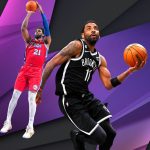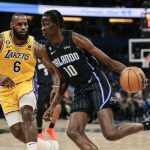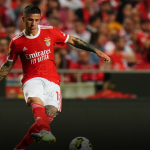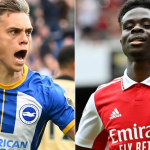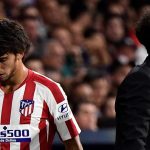AS THE 3-5 Golden State Warriors transition eras in real time, missteps and all, it has been hard not to imagine what this team would be like without Draymond Green — and the forms it might have taken had they never discovered his greatness.
The Warriors held both the 30th and 35th picks in the 2012 draft, and had their choice of Green and Festus Ezeli at No. 30. They picked Ezeli. “We decided we had to get a center first,” Kirk Lacob, now the team’s executive vice president of basketball operations, told me during the 2015 NBA Finals. “I was confident Draymond would still be there at No. 35. He’s a four-year player, he’s short, he’s slow. He was going to slip.”
Before that first championship season — Green’s third in the NBA — Steve Kerr had Green penciled in for 10 to 12 minutes as David Lee’s backup. Then Lee suffered a hamstring injury; Green seized the starting role, and has held it over a decade and four championships.
In hindsight, all of that somehow feels inevitable: that Stephen Curry, Klay Thompson, and Green were destined to win together — their skills so perfectly complementary, blurring into a cyclone (the Warriors actually have a play they don’t use much anymore called “Cyclone”) of cuts and passes and bodies in motion. There is something almost mystical about their connection. It is the type of bond that can develop only over thousands of shared high-stakes moments. It is sports nirvana.
Four months after a glorious, affirming championship, nirvana and mortality collided. The Warriors came to terms with Andrew Wiggins and Jordan Poole on massive extensions; they struck no deal with Green, and did not hold substantive discussions with Thompson, sources said. (Green has a player option for next season. Thompson cannot become a free agent until July 2024; the Warriors have more time to negotiate with him.)
Houston Rockets:
Kevin Durant was injured, leaving the “old” pre-Durant Warriors to close out their would-be usurpers. Green and Curry call this play the “hand-back.” Green has told me he does not remember which of them suggested it in the heat of the game. Golden State had been dicing up Houston with the same sideline pick-and-roll for most of the fourth quarter. The Rockets were trapping Curry, catapulting Green into the 4-on-3s that drowned the league from 2014 on:
P.J. Tucker would lunge away from Green, swarm Curry, and sprint into the paint to try to catch Green there. If Green stopped short, pitched the ball back to Curry, and slammed Curry’s guy with a pick, Tucker would not be able to reverse momentum in time to bother Curry’s shot.
Everything starts with the need to double Curry 30 feet from the rim. That was not something that happened before Curry. That basic reality — two players on one, almost at half-court — is the keystone to everything. It contains many pathways to championship glory.
Those pathways did not have to include Green. It’s easy to imagine an alternate reality where the Warriors never draft Green, turn Harrison Barnes into a full-time power forward, and acquire an above-average rim-running center — someone like Clint Capela. Toss in one more playable wing, and you have a traditional spread pick-and-roll helmed by the greatest shooter ever.
Ironically, this is the style for which some of Kerr’s critics have long agitated. The Warriors routinely rank toward the basement in total pick-and-rolls. It is a style we have seen now and then with Green on the bench, and Looney working as Curry’s rim-runner — three shooters around them.
Rivalries on opening night
• Must-see Christmas Day lineup
• Games you won’t want to miss
• Videos: Top schedule release reactions
• Full NBA schedule
Curry might have to drive, dribble, and absorb contact more in a spread pick-and-roll system than in Golden State’s beautiful game. Is that more draining than the way he bobs and weaves and screens away from the ball? It’s tough to say, but the Warriors have always believed pounding the ball — facing the constant attention of all five defenders — is more taxing.
Think back to that sequence of Curry-Green pick-and-rolls against the Rockets in 2019: the variety, the deep bag of counters, the frightening sense that you have no idea what’s coming. That would not build to the same nervous mania with Curry running a more typical system.
The willingness of Curry and Thompson to move without the ball — and the creativity with which they do it — is the most important engine of Golden State’s symphony. They make the system unpredictable. But Green enhances that unpredictability in a way no other big man could. He has been at least Golden State’s co-point guard, averaging about seven assists per game in most seasons. That number differentiates him from most low-scoring role player stars.
There are a bunch of other screen-setters who thrive in those 4-on-3 situations. Green, though, is the very best. The centers who approach Green’s passing vision are slower on their feet; options close in the time it takes them to catch, pivot, and rev up. Those who can match Green’s footspeed are typically wings — too small to defend centers and even some power forwards.
And that, of course, is Green’s true separator: all-time great defense. Green is the best and most versatile defender of the past decade — the perfect counter for modern pace-and-space offenses. There is no “Death Lineup” — super small, overstocked with shooting and playmaking — without Green to switch everything and anchor the back line. How many people could credibly defend James Harden one round, and Nikola Jokic in the next?
The Capela-type rim protectors can’t do all that. You can build a top defense around them, but it wouldn’t be as flexible. (The Warriors are going through growing pains on defense with Wiseman now.)
Celtics-Cavs, 7:30 p.m.
Grizzlies-Blazers, 10 p.m.
![]()
![]()
Friday
Bulls-Celtics, 7:30 p.m.
Bucks-Wolves, 10 p.m.
*All times Eastern
On offense, that theoretical Warriors team wouldn’t play with the same velocity and five-out spacing. Green was never a great shooting threat, but his ability to orchestrate from up top opened the floor anyway. Green’s passing helped Golden State get away with pairing him and various non-shooting, defense-first centers — Andrew Bogut first, Looney now — in more traditional lineups.
Curry and Thompson — not Green — are the main enablers of those big lineups. Their combined shooting offers Kerr the luxury of playing more defense-first types.
That is not a slight on Green, really. He helped imbue the offense with an unusual form. It was as productive in that form as it would have been in any other with the Splash Brothers. Green did not take away from that production, and is the single biggest reason (by far) the Warriors have been an elite defensive team for almost his entire tenure. He also deserves credit for buying into a low-scoring role, even if he had no choice and knew it would lead to winning — which would lead to fame.
GREEN IS NOW a four-time All-Star with four rings, two All-NBA designations, and one Defensive Player of the Year. He is a likely Hall of Famer. It says something that he became an archetypal player: We need our version of Draymond Green. How many false Greens have there been? You even hear scouts discuss sub-types: Grant Williams could be Draymond Green without the playmaking.
Would Green have been all that on any other team? Probably not. Most other apex superstars would have not ceded ballhandling duties to the cinder-block, non-shooting forward with the roaring soul as Curry did. Green would bog down the spacing as a stand-still secondary option.
But peak Green would have been very good in lots of places. Other teams would have found ways to leverage his playmaking; they would not have turned Green into an unguarded bystander to some vanilla pick-and-roll offense. They could stash him in the strong-side corner — a no-help zone — have him set flare screens, involve him in decoy actions, let him lurk in the dunker spot. Heck, you see some of this now when Green and Wiseman play together:
He’d have still set plenty of screens, sometimes as the solo center in ultra-small lineups and sometimes with another big man ready to catch lobs near the rim — a regular Warriors set-up for years. It’s not a coincidence Green has played on winning teams in high school, college, and the NBA.
That there is a canyon between Curry and every other factor driving Golden State’s dominance does not make the other top players — Green included — fungible. Lifting talent is a talent in itself. Green is and was a legitimate star in his own right, and if this is his last season with the Warriors — not even close to a sure thing — the team will never look, sound, or feel the same again.
